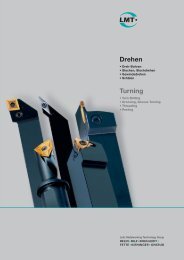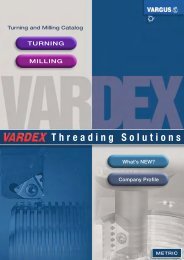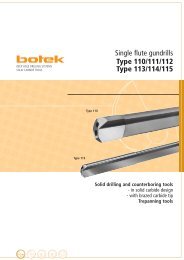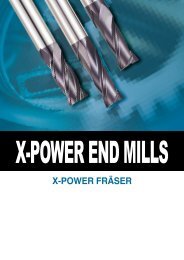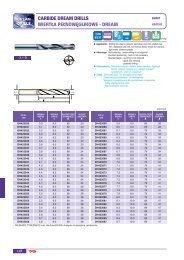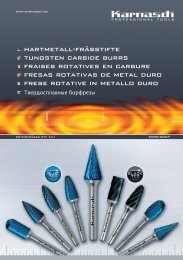Gear Cutting Tools
Hobs - Torion
Hobs - Torion
- No tags were found...
You also want an ePaper? Increase the reach of your titles
YUMPU automatically turns print PDFs into web optimized ePapers that Google loves.
Carbide skiving hobs<br />
Process and<br />
range of applications<br />
Skive hobbing is a machining process<br />
in which skiving hobs are<br />
used for cutting rough-milled and<br />
hardened gears.<br />
The main area of application is the<br />
hobbing of straight and helical<br />
spur gears. In addition, external<br />
splines, roll profiles and a large<br />
number of special profiles which<br />
can be generated by the hobbing<br />
method can be machined with the<br />
skiving hob. There are various reasons<br />
for using this process:<br />
Finish-hobbing of gears<br />
Skive hobbing eliminates hardening<br />
distortion and improves the<br />
quality of the gear.<br />
The metal removal capacity is considerably<br />
higher with skive hobbing<br />
than with the usual grinding<br />
processes. It is therefore economical<br />
to replace grinding by skive<br />
hobbing in the range of coarse and<br />
medium gear tolerances.<br />
<strong>Gear</strong> quality grade 6 to DIN 3962<br />
can be quoted as an approximate<br />
value for the attainable accuracy.<br />
Profile- and flank modifications,<br />
too, such as depth crowning, tooth<br />
face setback or width crowning,<br />
can be produced by suitable hob<br />
profiles and corresponding machine<br />
motions.<br />
The tool<br />
Design<br />
The characteristic design feature<br />
of skiving hobs is the negative tip<br />
rake angle. The tip rake angle is<br />
described as negative when the<br />
cutting faces of the teeth lie, in the<br />
direction of the cutting motion, in<br />
front of the tool reference plane.<br />
The tool reference plane is the<br />
plane in which lie the tip cutting<br />
edges of the axially parallel cutter<br />
and cutter axis.<br />
Due to the negative tip rake angle,<br />
the flank cutting edges are inclined<br />
in relation to the effective reference<br />
plane (plane perpendicular to<br />
the cutting motion) and in this way<br />
produce a peeling cut.<br />
The negative rake angle is greater<br />
in the root area of the hob teeth<br />
than in the tip area. The tip cutting<br />
edges have no effective back rake<br />
and cannot therefore generate a<br />
curling cut. It therefore follows that<br />
the skiving hobs should only produce<br />
flank chips and that protuberance<br />
cutters are used for<br />
roughing the gears.<br />
Tool material<br />
Low chip thickness and hardened<br />
gear materials make severe demands<br />
on the edge strength of the<br />
tool material. As the tool material<br />
for skiving hobs, carbides of ISO<br />
application groups K 05 to K 15<br />
are used.<br />
Designs<br />
Depending on the module size and<br />
the accuracy requirements, 3 skiving<br />
hob designs can be basically<br />
distinguished:<br />
■ Solid carbide<br />
up to and including module 4<br />
FETTE Cat. no. 2028<br />
■ Brazed-on carbide tips<br />
for modules above 4<br />
FETTE Cat. no. 2129<br />
■ Indexable carbide inserts<br />
for modules from 5 upwards<br />
FETTE Cat. no. 2153<br />
– γ<br />
v c<br />
λ s<br />
-–γ γ = Kopfspanwinkel<br />
tip rake angle<br />
λ s = Neigungswinkel back rake of der the Flankenschneide<br />
flank cutting edge<br />
v Schnittgeschwindigkeit<br />
c = cutting speed<br />
Fig. 2<br />
Preparation for grinding<br />
For high gear quality requirements,<br />
the gears are ground. The gear<br />
cutting costs can be markedly reduced<br />
if the hardening distortion is<br />
before grinding removed by skive<br />
hobbing, at the same time removing<br />
material down to the necessary<br />
grinding allowance. Grinding times<br />
and costs are reduced while gaining<br />
additional grinding capacity.<br />
Fig. 1<br />
40



